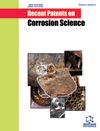- Home
- A-Z Publications
- Recent Patents on Corrosion Science
- Previous Issues
- Volume 3, Issue 2, 2013
Recent Patents on Corrosion Science - Volume 3, Issue 2, 2013
Volume 3, Issue 2, 2013
-
-
Corrosion Inhibitor Patents in Industrial Applications – A Review
More LessAuthors: R.G. Inzunza, Benjamin Valdez and Michael SchorrCorrosion affects the quality of the environment, the durability of the infrastructure assets and industrial equipments. Therefore, it is crucial using corrosion engineering control methods and techniques, in particular safe "green" e.g. environmental friendly corrosion inhibitors that will extend the life of the infrastructure saving large expenses in materials equipment and structures. This review presents an analysis of patents on Read More
-
-
-
A Review on Corrosion Protection of Iron and Steel
More LessBy Javed AkhtarFerrous based-metals, e.g., iron metal and metal alloys containing iron (mild steel), and steels are routinely used in the construction of cooling systems and in other fields due to their low cost and availability. Environmental considerations have been of paramount importance. Corrosion resistant stainless steel or “super alloys” have been used in applications where prevention of corrosion of steel structures or pipes was a Read More
-
-
-
Recent Patents on Physical and Chemical Vapour Deposition for Static and Fatigue Corrosion Protection of Thin Coated Components
More LessAuthors: S. Baragetti and F. VillaThe use of Physical Vapor Deposition (PVD) and Chemical Vapor Deposition (CVD) thin coatings has become a widespread practice in the design of components subject to an aggressive environment. Corrosion in an aggressive environment can be critical for the design of structural components under constant and fatigue loads, due to the presence of Stress Corrosion Cracking (SCC) and fatigue corrosion. The protection from ag Read More
-
-
-
Monitoring Electrochemical Degradation of Concrete Structures
More LessAuthors: Paulo S.D. Brito and Pedro RomanoThis paper intends to review the main systems of monitoring the degradation of reinforced concrete structures with steel that have been patented in the last 10 years. Given that the degradation process in the large majority of cases is an electrochemical corrosion process of the reinforcement caused by chemical actions on the structure, the systems are generally systems that determine electrochemical greatnesses. The syste Read More
-
-
-
X-Ray Photoelectron Spectroscopy Characterization for the Electrochemical Corrosion of Bulk Nanocrystalline 304 Stainless Steel in Hydrochloric Acid
More LessThe electrochemical corrosion properties of bulk nanocrystalline 304 stainless steel produced by severe rolling technique and its conventional polycrystalline 304 stainless steel were studied by immersion test for 20 days in 0.5 mol/L HCl solution at room temperature. The corrosion rate of bulk nanocrystalline 304 stainless steel was less than that of conventional polycrystalline 304 stainless steel. The electronic structures an Read More
-
Volumes & issues
Most Read This Month
Article
content/journals/rptcs
Journal
10
5
false
en


